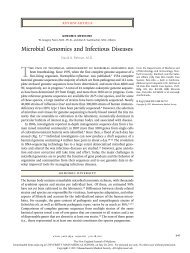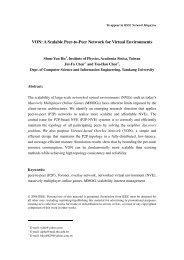366.7 KB - Evernote
366.7 KB - Evernote
366.7 KB - Evernote
Create successful ePaper yourself
Turn your PDF publications into a flip-book with our unique Google optimized e-Paper software.
If the two are not the same, the function just returns. This looks interesting: nothing is done to divert<br />
the target thread from its execution path. On one hand, it makes sense: as long as the thread is<br />
attached to a different environment, it can’t process the APC being scheduled. On the other hand, this<br />
means that the code which switches the thread to a new environment will check whether there are<br />
APCs in the list for it and act to divert the thread to service them.<br />
This is the first of many cases where the APC interrupt is not used.<br />
This logic means that kernel mode APCs, even special ones, are kept waiting until the thread<br />
switches environment on its own accord.<br />
If the environments match, nt!KiInsertQueueApc goes on to check whether the APC is for the<br />
currently executing thread, i. e. the one inside the function itself.<br />
Kernel APC for The Current Thread<br />
For this scenario, nt!KiInsertQueueApc sets KernelApcPending to 1 in the ApcState member of the<br />
target _KTHREAD.<br />
As wa saw in the section titled APC Process Context, ApcState stores the main APC environment, i.<br />
e. the one currently active. Since we have already deterrmined that our APC is for the active<br />
environment, we access the control variables for it directly from the ApcState member, instead of<br />
using the environment index and the pointer array _KTHREAD.ApcStatePointer.<br />
KernelApcPending is a very important flag, which plays a crucial role in breaking into the execution of<br />
the thread and making it deliver the APC.<br />
The SpecialApcDisable Flag<br />
After setting this flag, nt!KiInsertQueueApc checks the flag _KTHREAD.SpecialApcDisable: if it’s not<br />
0, the function returns.<br />
This means SpecialApcDisable can disable all kinds of kernel mode APCs, including special ones.<br />
When will then the APC be dispatched? Part of the answer can be found in nt!SwapContext. This<br />
function is executed to load the context of a thread after it has been selected to run and checks the<br />
KernelApcPending flag: if it is set and if SpecialApcDisable is clear, it triggers APC dispatching for the<br />
thread. We will see in greater detail later how this happens. For now, let’s just keep in mind that<br />
having KernelApcPending set guarantees to have APC dispatched the next time the thread is<br />
scheduled to run (providing that SpecialApcDisable has been cleared in the meantime).<br />
This begs the question of what happens if the current thread clears its own SpecialApcDisable: do<br />
pending APCs have to wait until it passes through nt!SwapContext or are they fired right away? If we<br />
try setting a breakpoint on write accesses to SpecialApcDisable for a thread of the system process,<br />
we discover there are several kernel functions which update this field, so, there is no single<br />
“EnableApc” function which clears it.<br />
However, all the functions I catched in a random test, update SpecialApcDisable according to the<br />
following pattern. To disable APCs, they decrement it when it is 0, therefore bringing it to 0xffff. To<br />
reenable them, they increment it, then check if the final value is 0. If this is the case, they check<br />
whether the list for kernel mode APCs has any and, if so, call a function named<br />
nt!KiCheckForKernelApcDelivery.<br />
This function triggers kernel APC delivery for the current thread. If the IRQL is passive, the function<br />
raises it to APC and calls nt!KiDeliverApc (detailed in a later section), which delivers the APCs.<br />
10
















